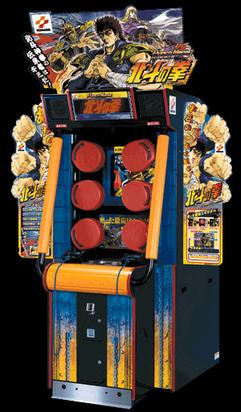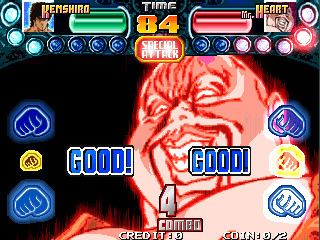9.5 /10 2 Votes
Initial release date March 2000 | 5/5 Emuparadise Sound PlayStation SPU | |||||||||||||||||||||||||||||||||
 | ||||||||||||||||||||||||||||||||||
Release date(s) Fighting Mania/Punch ManiaINT: March 2000Punch Mania 2JP: December 2000 CPU R3000A 32 bit RISC processor Similar Fist of the North Star, Black Belt, Fist of the North Star: Ken's Rage, Last Battle, Fist of the North Star: Ken's Ra | ||||||||||||||||||||||||||||||||||
Fighting mania arcade with wez larry fist of the north star let s play
Fighting Mania: Fist of the North Star, released in Japan as Punch Mania: Hokuto no Ken (パンチマニア 北斗の拳, Panchi Mania Hokuto no Ken), is a boxing game based on the manga series Fist of the North Star released by Konami in 2000 as a coin-operated arcade game.
Contents
- Fighting mania arcade with wez larry fist of the north star let s play
- Fighting mania fist of the north star arcade machine
- Cabinet
- Gameplay
- Playable characters
- Regional differences
- Sequel
- New game modes
- References

Fighting mania fist of the north star arcade machine
Cabinet

The arcade cabinet stands about 6'2" tall, 34" wide (when facing the machine), and about 4' deep. The monitor is recessed into the cabinet a fair distance, and in the front of the cabinet are six orange, sturdy punching pads with red LED lights embedded near their hinges. The pads are at rest along the inside walls of the recession of the cabinet, lining the monitor. There are also two black plastic "special gloves" that rest in pockets on the front of the machine, which are normally tied with rope or chain to the arcade cabinet to prevent theft. The player is to wear these gloves while playing (although it is also common practice to play without the gloves, though this can scrape the knuckles).
Gameplay

When an on-screen enemy makes an attack on the player, a punch pad will swing out on its hinge at a smooth pace, and upon reaching full extension at 90 degrees, the LEDs light up red. The pad stays lit for a short time, and then the pad returns inside the cabinet to rest. The player must punch this pad while the LEDs are lit. The strength of the player's punch is irrelevant to the game, and the game warns the player not to punch hard, to prevent the risk of breaking the machine. Only the timing of the punch is important, punches should be delivered at half strength, with exact timing.

Punching a pad when it is fully extended and the LEDs lit results in the attack being blocked, and the opponent receiving damage in the form of a counter-attack. Punching too early or too late results in either blocking the move with no counter-attack, or receiving lessened damage from the attack, also with no counter-attack damage to the opponent. Missing a pad completely (the pad retracting without ever being hit) results in full damage taken by the player. As opponents get more difficult - and particularly when they use their special moves - punches will be thrown and pads will pop out in faster succession and in more chaotic patterns, or special precautions may need to be taken, such as only striking one pad that is lit while other dummy pads pop up, or striking pads in the exact order they deploy.

Like conventional fighting games, the player has a life gauge at the top, and the enemy has a life gauge that must be brought to zero as well. Also both characters have a tech meter, in the form of seven stars remotely resembling the Big Dipper'. As attacks are landed or damage is taken, the stars light up along the super gauge and when full, the game will automatically execute the special move for the player. The game will also instruct the player how to use the particular special move it chose, based on the enemy the player is fighting. The game follows the Fist of the North Star series, as each enemy is not only a character from the series, but the finishing moves the player must use to defeat them are taken from the series as well. The game grades the player's performance based on their remaining life, agility, wisdom (wiz), skills and the use of finishing moves (arts).
At the start of the game, the player must choose their course. Each course consist of a set of opponents within a certain story arc. This serves as a difficulty setting. The first course is a tutorial where Kenshiro's master, Ryuken, will teach the player how to play the game and explain the finer points of timing punches. The subsequent courses involve progressively harder opponents moving toward the right, and are based on specific story arcs in the manga.
Playable characters
Regional differences
A few differences exist between Fighting Mania and Punch Mania.
Sequel
Punch Mania: Hokuto no Ken 2: Gekitō Shura no Kuni Hen (パンチマニア 北斗の拳2 激闘 修羅の国編, Panchi Mania Hokuto no Ken Tsū: Gekitō Shura no Kuni Hen, "Clash at the Land of Asura") is a sequel to the original Fighting Mania that was released on December 2000. In addition to containing all seven courses from the original game, the sequel adds five additional paths based on the later portion of the manga (the Hokuto no Ken 2 anime series), including one where the player controls the bounty hunter Ein, as well as a few new game modes. The sequel was distributed in a deluxe two monitor cabinet that allowed two-players to play simultaneously in competitive matches against each other or cooperative against the computer.
